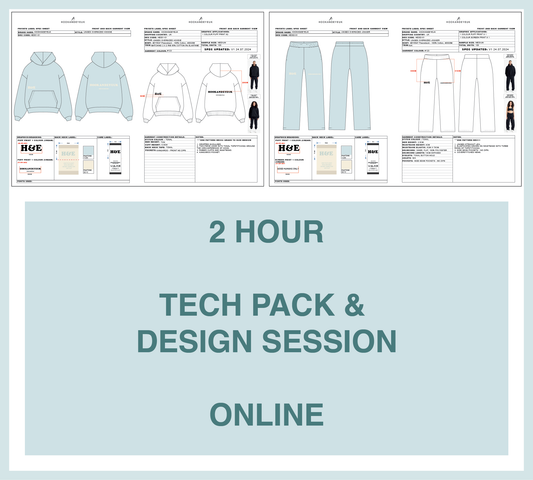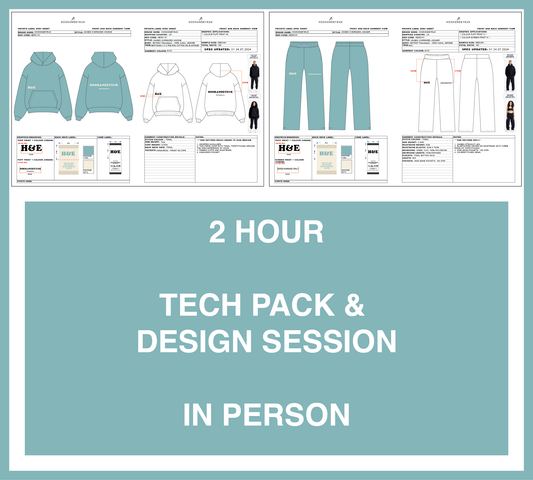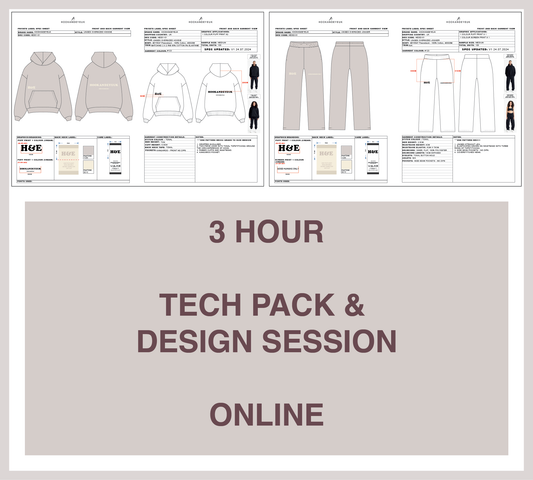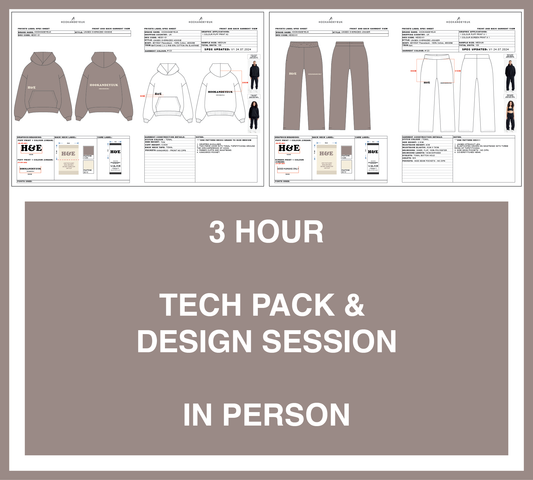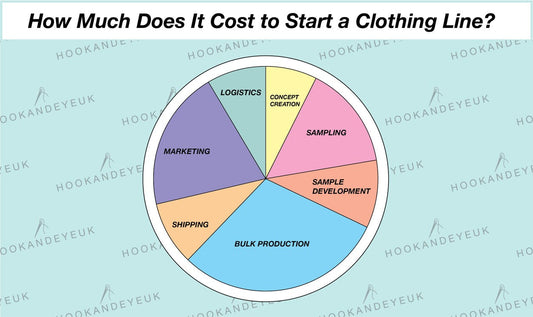A ‘Technical Package’ often referred to as a tech pack is any designers vital first step. In fashion design and garment production, creativity and technical precision must work hand in hand. This is where a tech pack becomes essential. Acting as the blueprint for your garment, a tech pack captures every detail manufacturers need to turn your design into reality—minimising errors, reducing costs, and keeping production on track.
At Hook and Eye UK, we know how vital this document is for both established brands and start-ups. Let’s break down what tech packs are, why they matter, and what they should include.
What is a Tech Pack?
A tech pack (short for technical package) is a detailed document that outlines everything about your garment—design, construction, materials, and measurements. It serves as a shared language between designers, product developers, and manufacturers, ensuring that your creative vision is translated accurately into production.
Think of it as the roadmap that guides your idea from sketch to finished product.

Who Uses a Tech Pack?
Tech packs are utilised by various professionals in the fashion industry, including:
· Fashion Designers: They use tech packs to communicate their creative vision and ensure that manufacturers understand their design intent.
· Product Developers: They translate creative concepts into manufacturable products, relying on tech packs to guide the production process.
· Manufacturers and Suppliers: They depend on tech packs to accurately produce samples and bulk garments, ensuring that the final product aligns with the designer's specifications.
· Startups and Entrepreneurs: For those new to the fashion industry, tech packs are invaluable in bringing ideas to life without incurring costly mistakes.
Why is a Tech Pack Important?
The importance of a tech pack cannot be overstated. Here are some key reasons why they are essential in garment production:
Clarity
A well-structured tech pack eliminates guesswork for manufacturers. By providing detailed specifications, it reduces the chances of errors and miscommunications, leading to a smoother production process.
Consistency
Tech packs ensure that garments meet quality standards and fit requirements consistently. This is particularly important for brands that aim to establish a reliable reputation in the market.
Efficiency
By streamlining the production process, tech packs help speed up timelines and simplify sourcing and cost estimation. This efficiency can be a significant competitive advantage in the fast-paced fashion industry.
Professionalism
Presenting a comprehensive tech pack demonstrates to manufacturers that a designer is serious and organised. This professionalism is key to building strong working relationships and fostering trust.
Key Components of a Hook and Eye UK Tech Pack
When we develop tech packs, we don’t just tick boxes—we create industry-standard documents tailored for production success. A strong tech pack should include:
Cover Page
The cover page should contain essential information such as the brand name, style name, item code, date and colour illustration. This serves as a quick reference for anyone reviewing the tech pack.

Technical Drawings & Fit Reference Images
Detailed technical drawings, often referred to as fashion flats, illustrate the garment from multiple angles. These sketches should include all construction details, such as seams and stitching, to provide a clear visual guide for manufacturers. Fit reference images can also be included to show how the garment should look when worn.

Bill of Materials (BOM)
The BOM is a comprehensive list of all materials required to produce the garment. This includes fabrics, trims, labels, and packaging materials. A well-defined BOM ensures that nothing is overlooked and helps determine the cost and sourcing of materials.
Labels and Packaging
Information about labels and packaging should also be included in the tech pack. This may cover details on care labels, hangtags, and how the garment should be folded or packaged for shipment.

Graphic and Trim Details
It’s important to state the graphic application method, sizing, code and colour here along with any hardware or trim specifications.

Construction Details
This section outlines the specific construction methods and techniques to be used in making the garment. It may include information on stitching types, seam allowances, and any unique construction features that are crucial for the garment's design.
Fit Comments and Revisions
As the garment progresses through the development process, fit comments and revisions should be documented. This allows for adjustments to be made based on fit samples and feedback, ensuring that the final product meets the desired specifications.

How to Create a Tech Pack
Creating a tech pack may seem daunting, but it can be a straightforward process if approached methodically. Here’s a step-by-step guide:
Step 1: Gather Design Data
Start by compiling all relevant design information, including sketches, fabric swatches, and any inspiration images. This foundational data will inform the rest of the tech pack.
Step 2: Compile Measurements/Fit References
Include all necessary measurements and sizing details to ensure an accurate fit as well as specific details for elements like collars and cuffs. Our tip is to always have a professional garment developer provide any measurements or (even-better) send a full digital pattern (for more on what a pattern is click here). There are specific ways in which to properly measure a garment and it’s easy to provide faulty sizing and end up in endless rounds of sampling! Where possible send a physical fit reference to be copied for general fit.
Step 3: Prepare the BOM
List all materials and trims involved in production to allow for cost calculation. This will help in budgeting and ensuring that the project remains financially viable.
Step 4: Annotate Images
Add comments and instructions to technical line drawings to highlight critical details. This visual guidance is invaluable for manufacturers. As before, having a professional garment developer (or designer) who understands garment construction is key to minimizing sampling rounds.
Step 5: Compile the Document
Use software like Adobe Illustrator or dedicated tech pack software to create a professional and organised layout. Ensure that all sections are clearly labelled and easy to navigate.
Final Thoughts
Creating a tech pack may feel like an extra step, but it’s one of the smartest investments you can make to get your product right the first time. Whether you’re working with a small local studio or managing overseas production, a detailed and professional tech pack is your best tool for clear communication, cost efficiency, and consistent quality control.
At Hook and Eye UK, we specialise in tech pack development and offer one-to-one design sessions with our expert team. Together, we’ll build industry-standard tech packs tailored to each garment in your collection—equipping you with everything you need to move forward confidently into costing, sampling, and bulk manufacturing.

If you’re starting out in fashion or simply want to take the guesswork out of production, our tech pack service gives you the structure and support you need to avoid costly mistakes and deliver premium results.
By understanding and using professional tech packs, you’ll not only make collaboration with manufacturers smoother but also protect your brand’s quality and reputation from the very beginning.
Ready to turn your ideas into production-ready garments? Our team can help with the entire process, from initial concept and tech packs, to sampling, to bulk production!
Contact Hook and Eye UK today to start your tech pack journey.
Hope you found this helpful,
H&E team :)



